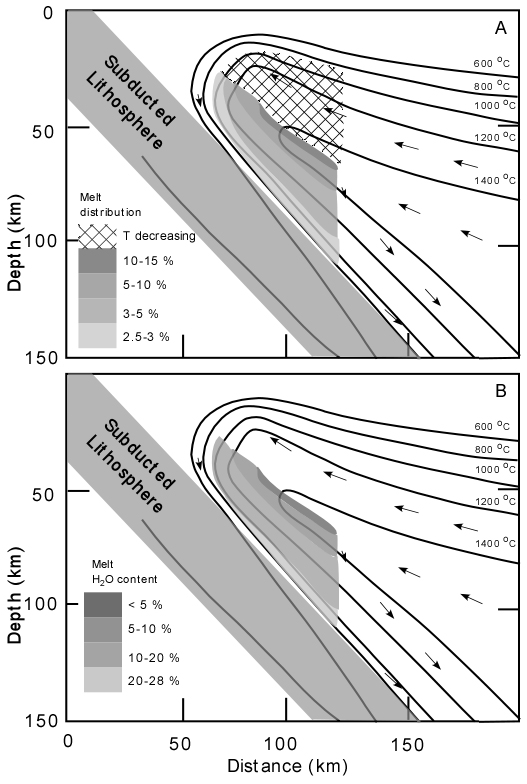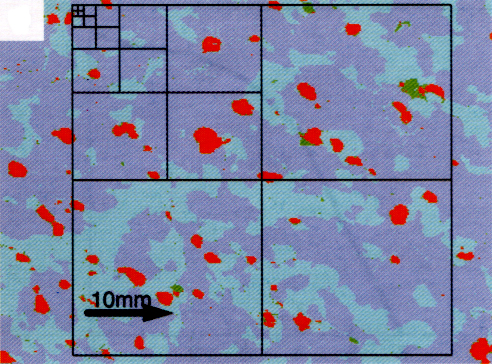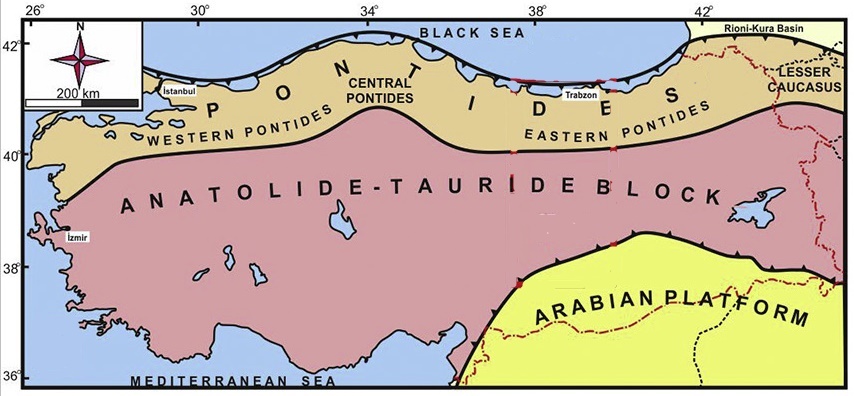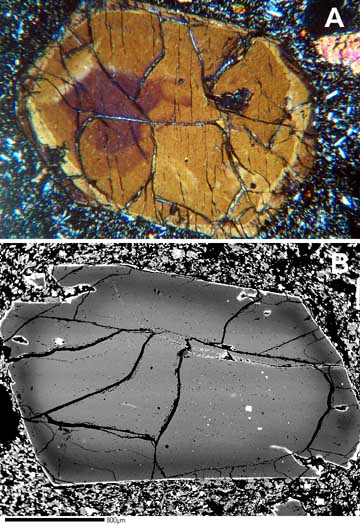Igneous petrology
Magmatism in subduction zones
 In subduction zones, arc magmatism is primarily driven by hydrous melting of peridotite. An H2O-rich fluid formed by dehydration of hydrous minerals in the subducted oceanic lithosphere rises into the overlying mantle wedge and causes flux melting up to shallow mantle depths (<30 km). The resulting melts segregate at the top of the wedge and pass through the crust where they differentiate and follow distinctive SiO2 enrichment paths at low FeO/MgO ratios.
In subduction zones, arc magmatism is primarily driven by hydrous melting of peridotite. An H2O-rich fluid formed by dehydration of hydrous minerals in the subducted oceanic lithosphere rises into the overlying mantle wedge and causes flux melting up to shallow mantle depths (<30 km). The resulting melts segregate at the top of the wedge and pass through the crust where they differentiate and follow distinctive SiO2 enrichment paths at low FeO/MgO ratios.
Arc magmas are generated in regions of overlap where temperatures in the mantle wedge are above the vapour-saturated peridotite solidus, and where hydrous minerals are unstable in the wedge and the subducting slab. These melting conditions, the slab dip and the convergence rate provide independent constraints on the thermal structure of the wedge and accurately predict the location of arc volcanoes.
Lunar fire fountains
Experiments show that the Apollo 15 green picritic glasses originated over a depth range of ~460-260 km within the moon. The compositional trend of the Group B glasses can be modeled by assimilating shallow melted cumulates into the Group A melts, whereas the trend for Group C can be modeled by a second assimilation event. In an initial intrusive event, a picritic magma crystallized and provided heat to melt magma ocean cumulates. In a later replenishment event, the picritic magma incrementally mixed with the melted cumulate, ascended to the lunar surface, and erupted as fire fountains. Vesicular rims on glass beads suggest that the fire fountains were driven by degassing of volatiles into the vacuum.
Peridotite xenoliths
 Kimberlite-hosted peridotite xenoliths from Kaapvaal Craton, South Africa record a unique thermal history. Modal and grain size distributions indicate that the xenoliths were produced by large extents of melting at shallow depths (~100 km) and high temperatures (~1500 °C) followed by burial to a depth of ~160 km and cooling to ~1100 °C. This process may have occurred in an Archaean subduction zone. A composite garnet harzburgite xenolith also shows evidence of metasomatism by a siliceous, volatile-rich fluid in a subduction zone, and provides evidence for large-scale modification of the Archean subcontinental mantle by subduction processes.
Kimberlite-hosted peridotite xenoliths from Kaapvaal Craton, South Africa record a unique thermal history. Modal and grain size distributions indicate that the xenoliths were produced by large extents of melting at shallow depths (~100 km) and high temperatures (~1500 °C) followed by burial to a depth of ~160 km and cooling to ~1100 °C. This process may have occurred in an Archaean subduction zone. A composite garnet harzburgite xenolith also shows evidence of metasomatism by a siliceous, volatile-rich fluid in a subduction zone, and provides evidence for large-scale modification of the Archean subcontinental mantle by subduction processes.
Publications
to top
Eastern Pontides, Turkey
 The Eastern Pontides Orogenic Belt of northeastern Turkey is a continental arc that is a part of the Himalayan-Alpine orogen. Some of the oldest rocks of this belt occur as small, discordant alkaline metagabbroic bodies in the Tokat Massif. These rocks are of Triassic age (c. 243-245 Ma) and they contain c. 460-2600 Ma inherited zircons that indicate interaction with a variety of crustal rocks during intrusion. The Pontides Belt initially formed above a south dipping subduction zone in the Permo-Triassic, and the Triassic gabbros intruded into the crust during back-arc rifting at the northern margin of Gondwana. Traditional models suggest that the ultramafic-mafic rocks exposed between the Pontide arc and the Tauride belt are remnants of a Jurassic ophiolite sequence. However, the new zircon U-Pb age data from mafic lithologies cutting the Kop ultramafic massif clearly indicate that the ultramafic lithologies are Paleozoic or older in age and are not remnants of a Jurassic ocean. In the Jurassic, c. 195-165 Ma old gabbro, tonalite and minor diorite intruded in the southern and axial zones of the orogenic belt. Thermobarometry indicates that they crystallized at P-T of 6-10 kbar and 1183-1250 °C. They are mostly tholeiitic, and they formed in an arc-type setting with minimal involvement of older crust or sediment.
The Eastern Pontides Orogenic Belt of northeastern Turkey is a continental arc that is a part of the Himalayan-Alpine orogen. Some of the oldest rocks of this belt occur as small, discordant alkaline metagabbroic bodies in the Tokat Massif. These rocks are of Triassic age (c. 243-245 Ma) and they contain c. 460-2600 Ma inherited zircons that indicate interaction with a variety of crustal rocks during intrusion. The Pontides Belt initially formed above a south dipping subduction zone in the Permo-Triassic, and the Triassic gabbros intruded into the crust during back-arc rifting at the northern margin of Gondwana. Traditional models suggest that the ultramafic-mafic rocks exposed between the Pontide arc and the Tauride belt are remnants of a Jurassic ophiolite sequence. However, the new zircon U-Pb age data from mafic lithologies cutting the Kop ultramafic massif clearly indicate that the ultramafic lithologies are Paleozoic or older in age and are not remnants of a Jurassic ocean. In the Jurassic, c. 195-165 Ma old gabbro, tonalite and minor diorite intruded in the southern and axial zones of the orogenic belt. Thermobarometry indicates that they crystallized at P-T of 6-10 kbar and 1183-1250 °C. They are mostly tholeiitic, and they formed in an arc-type setting with minimal involvement of older crust or sediment.
Late Cretaceous (c. 92-65 Ma) high-K calc-alkaline, shoshonitic, and alkaline rocks (trachyandesites and leucitites) occur in distinct E-W oriented zones from north to south. The rocks are younger southward, suggesting southward subduction. The samples exhibit a typical arc-type signature: LILE and LREE enrichment, negative Nb, Ta, and Ti anomaly, and positive Pb anomaly, and their isotopic compositions indicate mixing between enriched subcontinental mantle and crustal sources. Thermobarometry indicates polybaric crystallization of clinopyroxene at 1120 °C and ~38 km depth followed by amphibole at T < 950 °C and ~8 km depth. Hypabyssal intrusives (c. 70-62 Ma) consisting of high-K calc alkaline and calc-alkaline rocks (trachyandesite and adakitic dacite-rhyodacite) occur in the back-arc region at Bayburt. They also show negative Nb, Ta and Ti anomalies, and positive Pb anomaly in their trace element patterns. They crystallized between P-T of ~9 kbar/1250 °C and ~2 kbar/800 °C. The intrusives host xenoliths of clinopyroxenite, hornblendite, gabbro, diorite, quartz syenite, and amphibolite that show similar P-T of equilibration. The hornblendite xenoliths have ages of 81-76 Ma, whereas the quartz syenites have ages of 70-66 Ma. The host rocks and xenoliths have similar Sr-Nd-Pb isotopic compositions, and the clinopyroxenite, hornblendite, and gabbro xenoliths are cognate with the host rocks. I-type and A-type granitoids and associated gabbros, also of Late Cretaceous age (c. 90-70 Ma), occur along a north-south traverse from the northern part of the Eastern Pontides Orogenic Belt to the Anatolide-Tauride Block. They formed by closed-system fractional crystallization to open system AFC processes as indicated by the presence of a TDM = 1.2-1.75 Ga component. The low SiO2-granitoids and the gabbros require a mantle-derived component in their origin. A c. 67 Ma old alkaline gabbroic body from Hayrat with crystallization conditions of 5.7-7.4 kbar and 1170-1000 °C exhibits OIB-type geochemical features, whereas the associated basalts are arc-type tholeiites. The gabbro originated from an enriched lithospheric garnet-bearing mantle source, whereas the basalts originated from a shallower spinel peridotite source. The Hayrat gabbro formed in an oceanic intraplate setting, and was accreted to the forearc during southward subduction of Paleotethyan lithosphere.
The Cenozoic volcanic rocks include andesites and felsic tuffs (c. 58-47 Ma) exposed in the Bayburt area. During this time, two oceanic plates separated by a mid-ocean ridge subducted southward. The andesites and felsic tuffs are the products of adakitic magmatism during the northward rollback of a south-directed subducting slab and opening of a slab window as a result of ridge subduction. The isotopic compositions indicate mixing between depleted mantle and a mafic lower crust or subducted oceanic crust component. Arc-parallel extension caused the opening of Early Cenozoic sedimentary basins in which the felsic tuffs were emplaced by pyroclastic activity at c. 47 Ma. At c. 46 Ma, granitoids were emplaced north of Bayburt, and small olivine-bearing gabbroic bodies of Lutetian age (c. 45 Ma) intruded along a narrow zone parallel to the southeastern coast of the eastern Black Sea basin. The gabbros are hosted within Late Cretaceous basaltic, andesitic, and dacitic volcanics, pyroclastic rocks and interbedded sedimentary rocks. Their textures suggest magma mixing, and thermobarometric calculations indicate polybaric crystallization at ~1250 °C. They show HFSE depletion consistent with an arc-related origin, and low to moderate LILE enrichment suggesting modest involvement of subducted oceanic sediment or crust. Their Sr-Nd-Pb isotopic compositions are consistent with a depleted peridotitic mantle source. They probably originated in the forearc region. The granodiorite and monzodiorite-dominated (low-K to high-K arc-type) and syenite-dominated (shoshonitic) intrusives include the Late Paleocene-Early Eocene (47-42 Ma) adakitic intermediate-felsic intrusions, Eocene mafic intrusions, and Eocene non-adakitic granitoid intrusions. Thermobarometry indicates that these intrusives equilibrated at mid- to shallow-crustal depths (~25-4 km).
Publications
to top
East Maui, Hawaii
 Post-shield alkalic lavas account for about 1% of the lavas on Hawaiian Islands. In eastern Maui, these lavas erupted on top of the voluminous shield-stage tholeiitic lavas as the island of Maui migrated northwestward with the Pacific plate beyond the Hawaiian plume axis. The alkalic lavas in East Maui belong to an older Kula and a younger Hana series. The latter erupted predominantly from vents near the Haleakala summit and along the southwest rift zone forming a series of cinder cones. Alkalic lava from Kolekole cinder cone on the southwest rift near the Haleakala crater have transitional compositions between Kula and Hana lavas. They predominantly consist of ankaramitic picro-basalts with reverse- or cyclic-zoned clinopyroxene (Fig. A) and olivine (Fig. B) phenocrysts that indicate magma mixing during formation. Calculated pressures of equilibrium between phenocryst-rims and their host lava corresponding with the minimum depths of the alkalic magma reservoirs are between 4.4 and 11.2 kb. The alkalic magma reservoirs at Kolekole may thus extend deep into the spinel lherzolite field of the upper mantle.
Post-shield alkalic lavas account for about 1% of the lavas on Hawaiian Islands. In eastern Maui, these lavas erupted on top of the voluminous shield-stage tholeiitic lavas as the island of Maui migrated northwestward with the Pacific plate beyond the Hawaiian plume axis. The alkalic lavas in East Maui belong to an older Kula and a younger Hana series. The latter erupted predominantly from vents near the Haleakala summit and along the southwest rift zone forming a series of cinder cones. Alkalic lava from Kolekole cinder cone on the southwest rift near the Haleakala crater have transitional compositions between Kula and Hana lavas. They predominantly consist of ankaramitic picro-basalts with reverse- or cyclic-zoned clinopyroxene (Fig. A) and olivine (Fig. B) phenocrysts that indicate magma mixing during formation. Calculated pressures of equilibrium between phenocryst-rims and their host lava corresponding with the minimum depths of the alkalic magma reservoirs are between 4.4 and 11.2 kb. The alkalic magma reservoirs at Kolekole may thus extend deep into the spinel lherzolite field of the upper mantle.
- Chatterjee, N. and Bhattacharji, S. (2010) Geological and Geochemical Studies of Kolekole Cinder Cone, Southwest Rift Zone, East Maui, Hawaii. In: Ray, J., Sen, G., Ghosh, B. (eds.) "Topics in Igneous Petrology, A Tribute to Professor Mihir K. Bose", Springer, Dordrecht Heidelberg London New York, p. 95-113. doi:10.1007/978-90-481-9600-5_5
- Chatterjee, N., Bhattacharji, S. and Fein, C. (2005) Depth of alkalic magma reservoirs below Kolekole cinder cone, Southwest Rift zone, East Maui, Hawaii. Journal of Volcanology and Geothermal Research, 145, 1-22. doi:10.1016/j.jvolgeores.2005.01.001





